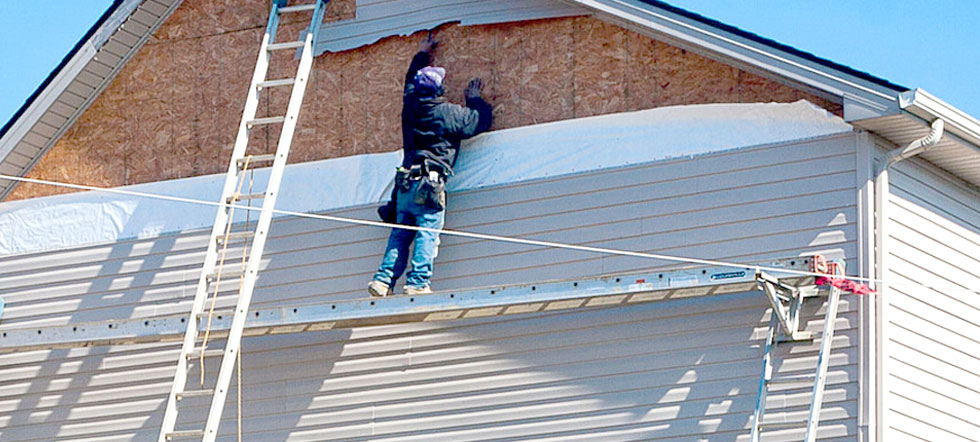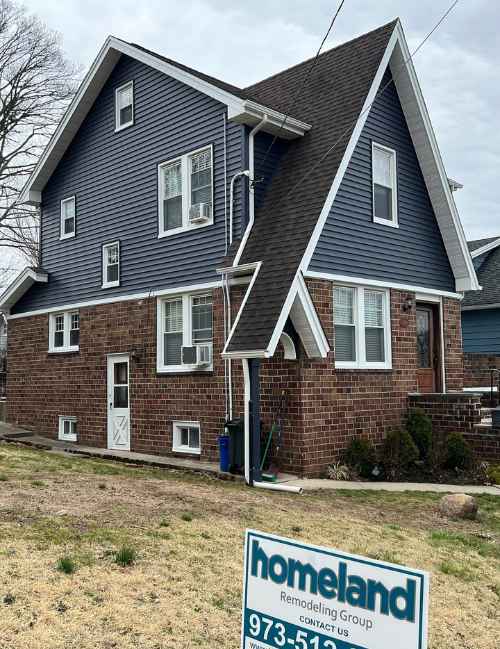The Necessary Guide to the Different Kinds of Exterior Siding and Their One-of-a-kind Benefits
In the realm of home renovation, selecting the ideal home siding is an essential decision that affects both visual appeal and practical efficiency. The variety of products available, such as wood, vinyl, fiber brick, cement, and metal, each offer one-of-a-kind advantages that provide to various requirements and choices. Understanding these distinctions can substantially boost the durability and value of a building - morris siding contractor. With so many choices to think about, which home siding product absolutely stands out for your details project? Discovering these choices can result in educated decisions that line up with both style and practicality.
Timber House Siding
Wood exterior siding, a prominent choice for domestic exteriors, offers an ageless aesthetic that incorporates all-natural charm with architectural honesty. This exterior siding product is readily available in various designs, including clapboard, roof shingles, and board-and-batten, allowing property owners to personalize their appearance to match their design choices. Timber house siding is typically crafted from long lasting types such as cedar, redwood, or want, which are recognized for their strength and ability to endure environmental stress factors.
Among the key advantages of wood siding is its exceptional insulation residential properties, which can add to energy efficiency and lower heating costs. Additionally, timber siding is naturally degradable, making it an eco-friendly option when sourced sustainably. Normal upkeep, consisting of paint or discoloration, can prolong its lifespan and enhance its appearance, permitting property owners to preserve the all-natural charm of the timber.
Nonetheless, potential disadvantages consist of susceptibility to insects, rot, and weather condition damages, requiring sufficient therapy and maintenance - morris siding contractor. In spite of these concerns, when appropriately taken care of, timber siding can offer a durable and gorgeous remedy that improves the character of a home while supplying a warm, inviting ambience

Vinyl Exterior Siding
Vinyl home siding has emerged as a leading option for property owners looking for a low-maintenance exterior alternative that combines durability and affordability. This flexible product is crafted from polyvinyl chloride (PVC), making it immune to numerous weather conditions, consisting of wetness and UV rays. Consequently, vinyl exterior siding does not warp, rot, or discolor, making certain lasting visual allure.
One of the main benefits of vinyl exterior siding is its considerable variety of styles and colors, enabling home owners to attain the wanted look for their property without the requirement for constant repainting. Furthermore, vinyl siding is very easy to install, which can dramatically reduce labor prices throughout building or restoration projects.
Plastic exterior siding also adds to power efficiency. Lots of choices function insulation backing, which enhances thermal performance, assisting to maintain comfortable indoor temperature levels and possibly lowering energy costs. Its smooth surface area assists in very easy cleaning, calling for only regular washing with a yard tube to eliminate dirt and debris.
Fiber Cement Siding
Fiber concrete home siding has gained grip among house owners and home builders alike due to its amazing combination of resilience and aesthetic adaptability. Made up of a mixture of sand, cellulose, and cement fibers, this exterior siding choice is engineered to stand up to extreme weather conditions, consisting of high winds, hefty rainfall, and temperature fluctuations, making it a lasting option for domestic outsides.

Among the key advantages of fiber cement home siding is its resistance to parasites, such as termites, and its click non-combustible nature, offering boosted fire safety and security. morris siding contractor. Furthermore, it is offered in a broad array of shades, designs, and appearances, allowing homeowners to accomplish their preferred aesthetic without sacrificing efficiency
One more advantage is its reduced maintenance requirements; fiber concrete home siding generally needs paint or discoloration every 5-10 years, which is less constant than other products. Its long life adds to a reduced overall price of ownership, as it minimizes the requirement for regular fixings or replacements.
Inevitably, fiber cement siding stands for an excellent investment for those looking for a resilient, attractive, and functional outside alternative, incorporating both kind and function to boost the home's aesthetic appeal.
Metal Home Siding
The attraction of metal house siding hinges on its durable sturdiness and contemporary visual charm, making it a favored option for contemporary architecture. Available in materials such as light weight aluminum and steel, metal house siding offers a series of shades and finishes, permitting home owners to accomplish a tailored look that matches their style vision.

Power effectiveness is one more substantial advantage, as numerous steel exterior siding products are created with insulation alternatives that aid manage interior temperatures. This can result in lowered energy costs with time. In addition, metal house siding is commonly recyclable, making it an eco-friendly selection for sustainability-minded house owners.
The installation process for steel house siding can be fairly uncomplicated, leading to a quicker turn-around time for building and construction projects. Overall, steel exterior siding combines capability and design, making it a functional choice for those seeking a aesthetically appealing and enduring exterior finish.
Brick and Rock House Siding
Brick and rock home siding stands out as a timeless choice that boosts the aesthetic appeal of any kind of home. Recognized for their resilience and low maintenance, these products give a remarkable return on investment while elevating the property's visual allure. Offered in various colors, structures, and patterns, block and rock can be tailored to suit diverse architectural designs, from conventional to contemporary.
Among the key advantages of block and stone home siding is their energy performance. Both materials possess natural insulating navigate here properties that aid control indoor temperatures, potentially reducing heating and air conditioning costs. Furthermore, they provide exceptional fire resistance compared to various other house siding choices, adding to enhanced safety.
Another benefit is their longevity. Block and rock can last for decades, usually calling for minimal upkeep beyond occasional cleansing. Unlike timber exterior siding, they are resistant to insects and rot, ensuring a lasting exterior that endures the components.
Conclusion
In summary, the selection of house siding dramatically impacts a home's visual charm, power efficiency, and upkeep demands. Each type of home siding-- whether wood, plastic, fiber block, concrete, or steel and rock-- provides one-of-a-kind advantages tailored to various home owner preferences and ecological problems.
One of the primary benefits of wood exterior siding is its exceptional insulation residential or commercial properties, which can add to energy effectiveness and lower home heating prices. Additionally, timber exterior siding is eco-friendly, making it an eco friendly alternative when sourced sustainably.One of the key benefits of metal house siding is its resistance to various ecological aspects.Energy performance is another substantial benefit, as many steel house siding products are made with insulation options that aid regulate helpful resources indoor temperature levels. Each kind of house siding-- whether wood, vinyl, fiber brick, steel, or cement and stone-- offers special benefits tailored to different property owner choices and environmental problems.